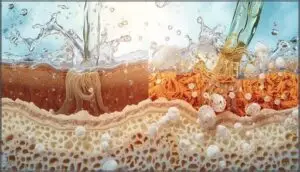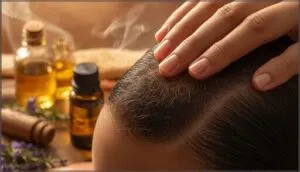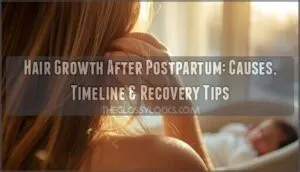This site is supported by our readers. We may earn a commission, at no cost to you, if you purchase through links.

Your hairbrush tells a story you don’t want to read—more strands each morning, a widening part, thinning edges that makeup can’t quite hide. By age 50, half of all men and women face pattern hair loss, a statistic that reflects genetics, hormones, and lifestyle converging at your follicles.
The frustration isn’t just cosmetic; it’s the loss of control over something you once took for granted. But here’s what the numbers don’t capture: your hair follicles aren’t dead, they’re dormant, and with the right combination of evidence-based treatments, nutritional support, and scalp care techniques, you can coax them back to life and reclaim what felt irretrievably lost.
Table Of Contents
Key Takeaways
- Your hair follicles aren’t dead but dormant, and evidence-based treatments like FDA-approved minoxidil and finasteride, combined with nutritional support (iron, biotin, zinc, vitamin D) and scalp care, can reactivate them within 4-18 months depending on the intervention.
- Androgenetic alopecia affects 50% of people by age 50 due to genetic factors and DHT sensitivity, while hormonal shifts (menopause, thyroid dysfunction), chronic stress elevating cortisol, and nutritional deficiencies trigger reversible hair loss patterns like telogen effluvium.
- Daily habits matter as much as medical treatments—sulfate-free gentle washing, avoiding heat above 365°F, eliminating tight hairstyles that cause traction alopecia, and maintaining scalp cleanliness create the foundation for follicle health and treatment absorption.
- Natural interventions like rosemary oil (matching minoxidil results after six months), scalp massage increasing circulation by 25%, and low-level laser therapy showing 17% density improvements offer evidence-backed alternatives, though consistency over 16+ weeks is essential before visible regrowth appears.
Causes of Hair Loss and Thinning
Hair loss doesn’t happen without reason—your body is always trying to tell you something. The triggers can range from what’s written in your DNA to what you’re eating, how you’re feeling, and what’s happening inside your body.
Let’s break down the most common culprits so you can identify what might be affecting your hair.
Genetic Factors and Androgenetic Alopecia
You might think hair loss is random, but it often follows a script written in your genes. Androgenetic alopecia—the technical term for male pattern baldness and female pattern hair loss—affects roughly 50% of men and women by age 50, with genetic factors playing the starring role.
- Sons of balding fathers face a 5 to 6 times higher risk, revealing clear inheritance patterns
- Your androgen receptor gene on the X chromosome influences hair follicle sensitivity to DHT
- Genetic testing and androgenetic research confirm that gene expression differences explain why some scalps resist thinning while others don’t
Understanding the hair growth process is essential for managing hair loss.
Hormonal Changes and Stress
Beyond genetics, hormonal changes and stress management play central roles in hair loss. Over 50% of postmenopausal women experience thinning as estrogen declines, while thyroid health affects 33–50% of those with thyroid dysfunction.
Elevated cortisol levels from chronic stress disrupt the hair cycle, pushing follicles from growth to shedding. Managing stress and maintaining hormone balance—especially during menopause—can notably support hair regrowth and preserve density.
Understanding the impact of high cortisol levels is essential for addressing hair loss effectively.
Nutritional Deficiencies (Iron, Biotin, Zinc, Vitamin D)
Nutritional deficiencies and hair loss often go hand in hand. Iron deficiency affects up to 59% of women experiencing hair thinning, while low zinc levels correlate strongly with telogen effluvium. Biotin deficiency, though less common, disrupts keratin production when present. Vitamin D levels below target ranges may impair follicle cycling.
- Iron supplements restore serum ferritin, reducing diffuse shedding
- Biotin aids keratin structure in deficient individuals
- Zinc levels regulate follicle recovery and prevent regression
Medical Conditions and Medications
Certain diseases trigger hair loss through distinct pathways. Alopecia areata, an autoimmune disorder affecting 2% of people worldwide, attacks follicles directly. Thyroid conditions cause alopecia in 30-40% of patients, while lupus and other autoimmune disorders disrupt growth cycles.
Chemotherapy effects appear in 65% of cancer patients, and medication side effects from antihypertensives or antidepressants can accelerate telogen effluvium. Androgenetic alopecia links to hypertension and diabetes in affected individuals.
Healthy Hair Care Routines
Your daily hair care habits can either protect your strands or accelerate thinning—and most people don’t realize which side they’re on.
Small adjustments to how you wash, style, and treat your hair make a measurable difference in follicle health and breakage rates.
Let’s walk through the essential practices that form the foundation of any effective hair preservation routine.
Gentle Washing and Conditioning Practices
Your washing routine can either fortify your hair or quietly sabotage it. Gentle hair care practices create the foundation for scalp health and hair regrowth while preventing unnecessary damage.
- Wash 5–6 times weekly with sulfate-free shampoos to maintain moisture retention without stripping natural oils
- Apply conditioner only to hair lengths, never your scalp, to avoid blocked follicles
- Use lukewarm water and gentle scalp massage motions during shampooing
- Pat hair dry with a microfiber towel instead of vigorous rubbing
- Choose fragrance-free formulations if you experience scalp irritation or sensitivity
Minimizing Heat and Chemical Damage
Heat styling above 365°F converts your hair’s keratin structure, making strands brittle and prone to hair breakage. Chemical treatments—coloring, straightening, perming—weaken the hair shaft and trigger dryness in nearly 90% of users.
To prevent damage, apply heat protectants before thermal styling, keep tools below 365°F, and space out chemical treatments. Embrace gentle styling habits and air-drying to safeguard hair growth while minimizing hair loss.
Protective Styling and Reducing Mechanical Stress
Tight braids, ponytails, and buns pull at your roots, creating mechanical stress that leads to traction alopecia—a preventable form of hair loss. Protective styles can shield your strands when installed loosely, but excessive tension triggers scalp inflammation and hair breakage.
Adopt gentle styling habits: choose looser updos, avoid extensions that strain follicles, and give your scalp regular breaks between styles to support long-term hair health.
Importance of Scalp Cleanliness
Your scalp is like soil for a garden—when clogged with oils, dead skin, and debris, hair follicles can’t thrive. A consistent cleanse routine washing 5-6 times weekly removes buildup that triggers inflammation and folliculitis, conditions that weaken follicle care and accelerate hair loss prevention failures.
Scalp hygiene directly influences scalp health: clean follicles absorb treatments better, while scalp massage during washing boosts circulation, supporting vigorous scalp care and healthier hair growth.
Nutritional and Lifestyle Strategies
What you eat and how you live directly influence your hair’s ability to grow and stay strong. Beyond topical treatments, your daily habits—nutrition, hydration, stress management, and sleep—create the internal environment your follicles need to thrive.
Let’s break down the specific strategies that can help you rebuild healthier hair from the inside out.
Diet for Hair Regrowth (Key Nutrients and Foods)
Your plate can become a powerful ally in the fight against hair loss. Prioritize protein intake from eggs, fish, and lentils to fuel follicle growth.
Iron deficiency sabotages hair health, so load up on spinach and lean meats alongside vitamin C-rich citrus for absorption.
Omega fatty acids from salmon strengthen strands, while biotin and folic acid support keratin production. Nutrient balance matters—hair foods work synergistically, not in isolation.
Essential Supplements for Hair Health
Supplements bridge nutritional gaps when diet falls short, but precision matters. Biotin benefits hair thickness primarily in deficient individuals, though mixed evidence exists for broader use.
Vitamin C boosts iron absorption, while zinc supplements require mineral balance—excess zinc ironically worsens loss. Target iron deficiency with medical testing first.
Folic acid and customized hair nutrition create synergy, yet over-supplementation risks lab interference and toxicity.
Hydration and Its Impact on Hair
Water intake shapes hair health more than you might expect—your strands contain roughly 25% water by structure. Dehydration weakens hair shafts, triggers breakage, and disrupts follicle function, pushing growth cycles into premature shedding.
Adequate hydration tips include drinking eight glasses daily and eating water-rich foods to maintain scalp health, support nutrient delivery, and preserve hair moisture. Dehydration effects compromise hair regrowth before you notice thinning.
Managing Stress for Hair Preservation
Your stress hormone cortisol directly sabotages hair follicle stem cells, stalling regeneration and prolonging dormancy. Stress management for hair health isn’t optional—chronic tension elevates cortisol, triggering telogen effluvium and worsening androgenetic alopecia.
Chronic stress elevates cortisol, which sabotages hair follicle stem cells and triggers shedding—making stress management essential for hair preservation
Mindful meditation, deep breathing, and regular physical activity lower cortisol levels and restore follicle function. Managing stress and hair loss together breaks the cycle where shedding fuels anxiety, which accelerates thinning.
Benefits of Quality Sleep
Stress isn’t the only lifestyle saboteur—your sleep patterns directly dictate hair regrowth. Sleeping fewer than six hours nightly markedly raises alopecia areata risk, while deep sleep benefits extend the anagen phase by up to 15%.
Circadian rhythms govern melatonin effects on follicles, boosting anagen rates from 76% to 85%.
Quality rest enhances scalp circulation, lowers cortisol for stress reduction, and accelerates cellular repair that reverses hair loss.
Effective Treatments for Hair Regrowth
When hair care and lifestyle changes aren’t enough, medical treatments can step in to help you regain what you’ve lost. The right approach depends on your specific type of hair loss, your goals, and how much intervention you’re comfortable with.
Let’s look at the proven options that can actually make a difference.
FDA-Approved Topical and Oral Medications (Minoxidil, Finasteride)
Among FDA-approved options, minoxidil and finasteride stand as the most evidence-backed treatments for hair loss. Minoxidil works topically in 2% or 5% formulations, applied twice daily, with about 74% of men seeing improved density.
Finasteride, taken orally at 1 mg daily, slows progression and stimulates regrowth—up to 80% of men report increased density within a year.
Low-Level Laser Therapy and Platelet-Rich Plasma
Beyond medications, low-level laser therapy and platelet-rich plasma represent advanced options for hair regeneration. Laser hair growth devices use red light wavelengths to stimulate dormant follicles, with studies showing up to 17% increases in terminal hair after 26 weeks.
Platelet therapy injects concentrated growth factors directly into your scalp, activating follicles and extending the growth phase—30-40% density improvements appear within 3-6 months.
Natural Oils and DHT Blockers
Natural oils for hair growth offer you a gentler path to combat DHT, the hormone behind follicle shrinkage. Consider these DHT blocking options with proven essential oil blends:
- Rosemary oil benefits match minoxidil results after six months, reducing enzyme activity by 80%
- Pumpkin seed oil inhibits the 5-alpha reductase enzyme
- Saw palmetto extract aids androgenetic alopecia treatment
- Coconut oil protects against protein loss and oxidative damage
Dilute rosemary oil in carrier oils before application, maintaining consistency for natural regrowth methods while minimizing oil treatment safety concerns.
Hair Transplant and Restoration Procedures
When medical treatments plateau, surgical hair restoration techniques offer your most definitive alopecia treatment option. Follicular Unit Extraction—66% of procedures—delivers 90-95% graft survival rates with minimal scarring, while Direct Hair Implantation pushes success beyond 90%.
Transplant costs range from $2,675 in Turkey to $13,610 stateside, with most patients requiring 1.5 sessions for ideal scalp health and hair regrowth density.
Scalp Care and Stimulation Techniques
Your scalp isn’t just the foundation for hair growth—it’s an active environment that reacts to how you treat it. Simple techniques like massage, targeted oils, and the right tools can improve circulation, reduce inflammation, and create healthier conditions for regrowth.
Here’s what actually works to support your scalp and strengthen your hair from the root.
Scalp Massage for Improved Circulation
When you stimulate your scalp through massage techniques, you’re not just indulging in relaxation—you’re directly enhancing blood flow to each hair follicle. Studies show scalp massage increases circulation by up to 25%, delivering critical nutrients and oxygen that support the hair growth cycle.
Here’s what proper scalp stimulation offers:
- Gentle circular pressure applied for 4-6 minutes daily
- Mechanical forces that activate growth-promoting cellular pathways
- Reduced cortisol levels that otherwise disrupt follicle function
Choosing and Using Essential Oils
Selecting effective essential oils requires understanding which compounds penetrate the scalp. Rosemary oil, when diluted to 2%, matches the performance of minoxidil, while peppermint oil deepens follicles more effectively than commercial treatments. Coconut oil is recommended as the carrier base, as it prevents protein loss during application.
| Essential Oil | Key Benefit |
|---|---|
| Rosemary | Blocks DHT, increases follicle count |
| Peppermint | Enhances circulation, deepens roots |
| Lavender | Reduces inflammation, thickens dermis |
| Lemongrass | Fights scalp infections naturally |
| Angelica/Ligusticum | Reverses DHT damage effectively |
To apply these aromatherapy benefits, dilute 10-15 drops of essential oil per ounce of carrier oil, massage into the scalp for 4-6 minutes, and leave overnight. Consistency is key with natural hair remedies; essential oil blends typically require 16+ weeks before measurable hair regrowth is noticeable.
Best Tools for Scalp and Hair Health
When you’re ready to invest in hardware that complements your regrowth routine, scalp massagers with rubber bristles boost blood flow to your hair follicle during each hair growth cycle and phases.
Low-level laser therapy devices—32 FDA-cleared options exist—noticeably increase density through targeted scalp care. Microneedling tools (1.5 mm) paired with topical treatments accelerate hair regrowth techniques, while AI scalp analyzers deliver precision diagnostics for customized scalp health and massage protocols.
Preventing Scalp Inflammation and Damage
Beyond tools, protecting your scalp from chronic inflammation is fundamental. Perifollicular inflammation appears in 71% of pattern hair loss biopsies, so gentle cleansing with anti-inflammatory ingredients becomes your first line of defense:
- Wash with sulfate-free formulas to preserve scalp health
- Apply topical corticosteroids for persistent redness
- Integrate omega-3-rich foods to lower inflammation markers
- Schedule scalp massage sessions to boost follicle circulation
Early intervention prevents permanent hair follicle damage.
Frequently Asked Questions (FAQs)
How long does hair regrowth typically take?
Hair regrowth depends on your hair’s growth cycle and chosen treatment. With minoxidil, you’ll notice improvement around 4-6 months. Finasteride shows results between 6-9 months, while transplants require 12-18 months for full density.
Can wearing hats cause permanent hair loss?
Forget the folklore—frivolous fears about hats don’t hold up. Typical hat use doesn’t trigger permanent hair loss.
However, tight hats may cause traction alopecia, and poor hat hygiene risks scalp infections damaging hair follicles.
Does caffeine shampoo actually promote hair growth?
Caffeine shampoo shows promise in blocking DHT and stimulating hair follicles, with studies demonstrating reduced hair loss after three to six months.
However, evidence remains limited, and regulatory bodies question broader hair growth claims pending larger trials.
Are hair loss patterns different across ethnicities?
Yes, hair loss patterns vary notably across ethnicities due to genetic variations, hair texture differences, and follicle sensitivity to DHT. Caucasians experience the highest incidence, while Native Americans show minimal androgenetic alopecia.
When should I see a dermatologist for hair loss?
You should seek a dermatologist referral if you’re shedding over 100 hairs daily, noticing patchy bald spots, experiencing persistent scalp symptoms, or feeling distressed.
Early medical evaluation and scalp examination improve hair loss treatment outcomes.
Conclusion
Your follicles aren’t finished, your confidence isn’t lost, and your options aren’t exhausted. The science is clear: when you manage hair loss and regrow hair with FDA-approved treatments, targeted nutrition, and disciplined scalp care, dormant follicles respond.
No miracles, no shortcuts—just evidence-based interventions that demand consistency. Start with one protocol today, track your progress monthly, and remember that regrowth measures in months, not days.
Your hairline won’t wait for perfect timing, so neither should you.










